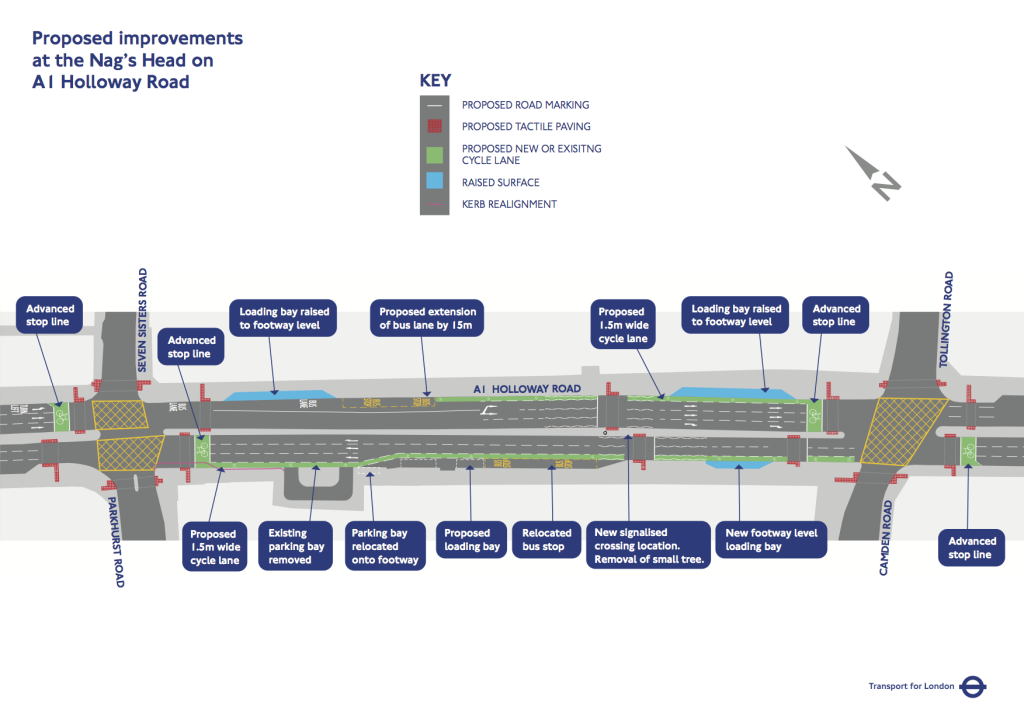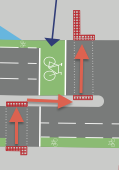This is my response to TfL’s public consultation at Nag’s Head on A1 Holloway Road. For when the consultation disappears on the TfL site, I have uploaded it to my blog Nags Head Junction Map and also to a Cyclescape thread.

As someone who has been involved with the London Cycling Campaign‘s Junction Review Group (now Infrastructure Review Group) from it’s inception, I’m appalled TfL are still coming up with dangerous designs such as this.
There are so many issues with these proposals I’m not sure where to start.
Advanced stop lanes are extremely dangerous and should not be introduced into any more junctions. They are the area of the blind spot of truck. Also many people riding bicycles find it scary to cross two never mind 3 lanes of traffic. Instead a protected cycle track of 2m width minimum plus separate timings to prevent left hooks. It is essential that left turning motor vehicles are not allowed to go at the same time as straight on cyclists otherwise there will be more deaths similar to the ones at Bow through left hooks. You also need to aid cyclists that are turning right in a protected Dutch style two stage turn.
Traffic lights need to be demand responsive. As cyclists are in their own track, this helps to tell when there are cyclists there rather than other modes of transport, and you can automatically adjust the timings for the demand of all traffic. This ties in with the previous point re separating left turning vehicles from straight on and right turning cyclists. This is standard practice in The Netherlands where signals will even turn red and straight back to green if there is still more cyclists there to promote cycling and reduce the probability of cyclists jumping the red light.

Why are TfL still introducing dog leg crossings? (Dog leg crossings are where you cross half way, walk sideways for a bit, and then cross the rest of the way). Have any of the designers or traffic engineers taken a look at how the current dog leg crossings are being used in London? Spending just a few minutes will show that they are not being used as designed. People don’t do the sideways walk as designed and just continue walking straight on as that is the fastest route to their destination. Adding railing back in is not a solution as pedestrians just walk around then, and also there is potential for pedestrians and cyclists to be crushed against them by motor vehicles. By building the crossings the way that users actually use them, will mean that the central reservation can be removed thus making room for a safe cycle track to be put in instead, and also make it safer for pedestrians. I don’t see motor vehicles having to do a sideways jump so why should pedestrians?
Why is the central reservation needed? Is it still there to make it feel safe for drivers to go fast along the road knowing that there won’t be a car coming the other direction on their side of the road?
Heading south east why does 2 lanes turn into a bus lane plus a very wide lane that may be wide enough for 2 small vehicles, which later turns into a cycle lane plus 3 lanes of traffic? The merging and splitting of traffic lanes causes traffic tailbacks and more collisions. Thus minimising the potential for lane changes would help to make the roads safer. Mixing cyclists in a bus lane is not going to encourage an inexperienced cyclist, or even an experienced cyclist who is scared of being run over after too many near misses in the past, to cycling in this location. This is why a protected cycle track is needed.
Why are the cycle lanes to the right of the bus stops and the loading bays? This creates a significant dooring and collision risk and will result in injuries or death of cyclists. Best practice in other countries such as The Netherlands shows that the cyclists should be between the pavement and the motor vehicles, including parking and loading motor vehicles, as this is the safest location.
Why is a 1.5m cycle lane seen as sufficient width? This does not allow for space for cyclists to be able to overtake safely in the lane, especially if one of them has a cargo bike or trailer. 1.5m may be the minimum, as specified by the London Design Standards section 4.2.7, however it does also stipulate 2m or more where space permits in several places in the document. In this instance there is enough space here to allow the 2 or more metres width.
Would you allow your 8 year old child to cycle on this road, or be happy for your 80 year old mother to cycle here after the proposals have been implemented. Would that be happy walking here? If not, the design isn’t good enough and you need to go back to the drawing board. Please stop this consultation and go back to the drawing board before wasting more time and money on dangerous designs.
[mapsmarker marker=”7″]